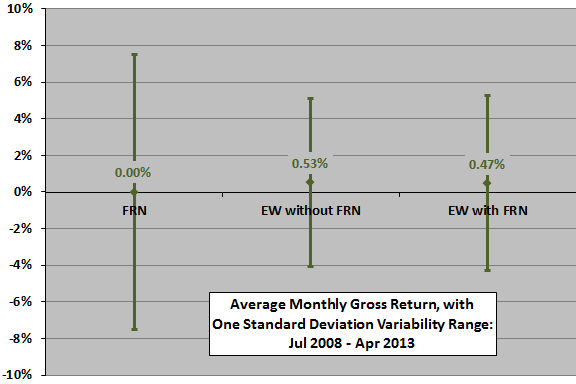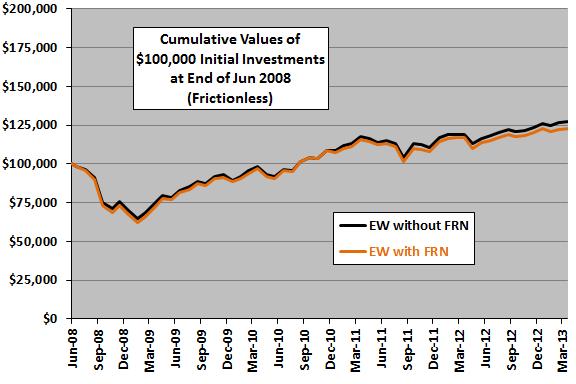Does adding a proxy for the least developed (frontier) equity markets to a diversified portfolio improve its performance? To check, we add Guggenheim Frontier Markets ETF (FRN) to the following mix of asset class proxies (the same used in “Simple Asset Class ETF Momentum Strategy”):
PowerShares DB Commodity Index Tracking (DBC)
iShares MSCI Emerging Markets Index (EEM)
iShares MSCI EAFE Index (EFA)
SPDR Gold Shares (GLD)
iShares Russell 1000 Index (IWB)
iShares Russell 2000 Index (IWM)
SPDR Dow Jones REIT (RWR)
iShares Barclays 20+ Year Treasury Bond (TLT)
3-month Treasury bills (Cash)
First, per the findings of “Asset Class Diversification Effectiveness Factors”, we measure the average monthly return for FRN and the average pairwise correlation of FRN monthly returns with the monthly returns of the above assets. Then, we compare cumulative returns and basic monthly return statistics for equally weighted (EW), monthly rebalanced portfolios with and without FRN. We ignore rebalancing frictions, which would be about the same for the alternative portfolios. Using adjusted monthly returns for FRN and the above nine asset class proxies from July 2008 (first return available for FRN) through April 2013 (58 monthly returns), we find that:
The following chart summarizes average monthly returns with variability ranges of one standard deviation for FRN and the EW portfolios without and with FRN over the available sample period. During this time, FRN generates a slightly positive average return with high volatility. Adding FRN to the diversified EW portfolio has little effect on return but modestly increases volatility. The ratio of average return to standard deviation (return per unit of risk) is 0.12 (0.10) without (with) an FRN position.
The average pairwise correlation of FRN monthly returns with those of the other assets is 0.50 over the available sample period, about the same as the other equity ETFs.
Per “Asset Class Diversification Effectiveness Factors,” the weak average return (high average pairwise correlation) of FRN indicates a weak (poor) contribution with respect to portfolio diversification.
Sample size is small in terms of number of months and, especially, variety of market conditions.
What is the net result of these opposing effects?

The next chart compares cumulative returns of EW portfolios without and with FRN in the mix over the available sample period. FRN is mostly a slight drag on performance.
Again, sample size is small.

In summary, evidence from simple tests over a short available sample period does not support belief that adding a proxy for frontier equity markets to a diversified portfolio improves overall performance.
It may be that FRN has become too highly correlated with other equity markets to aid diversification.
Cautions regarding findings include:
- As noted, the sample period is very short in terms of market conditions. If FRN were available over a longer period, findings might be different. In other words, over the long term, FRN may prove an effective diversifier. See “Frontier Market Costs and Benefits” and “Risk-based Allocation to Frontier Equity Markets”.
- Including the trading frictions associated with monthly rebalancing would depress performance of both portfolios, depending mostly on portfolio size. When a portfolio of X assets performs just as well as one with X+1 assets on a gross basis, the former may be superior on a net basis.